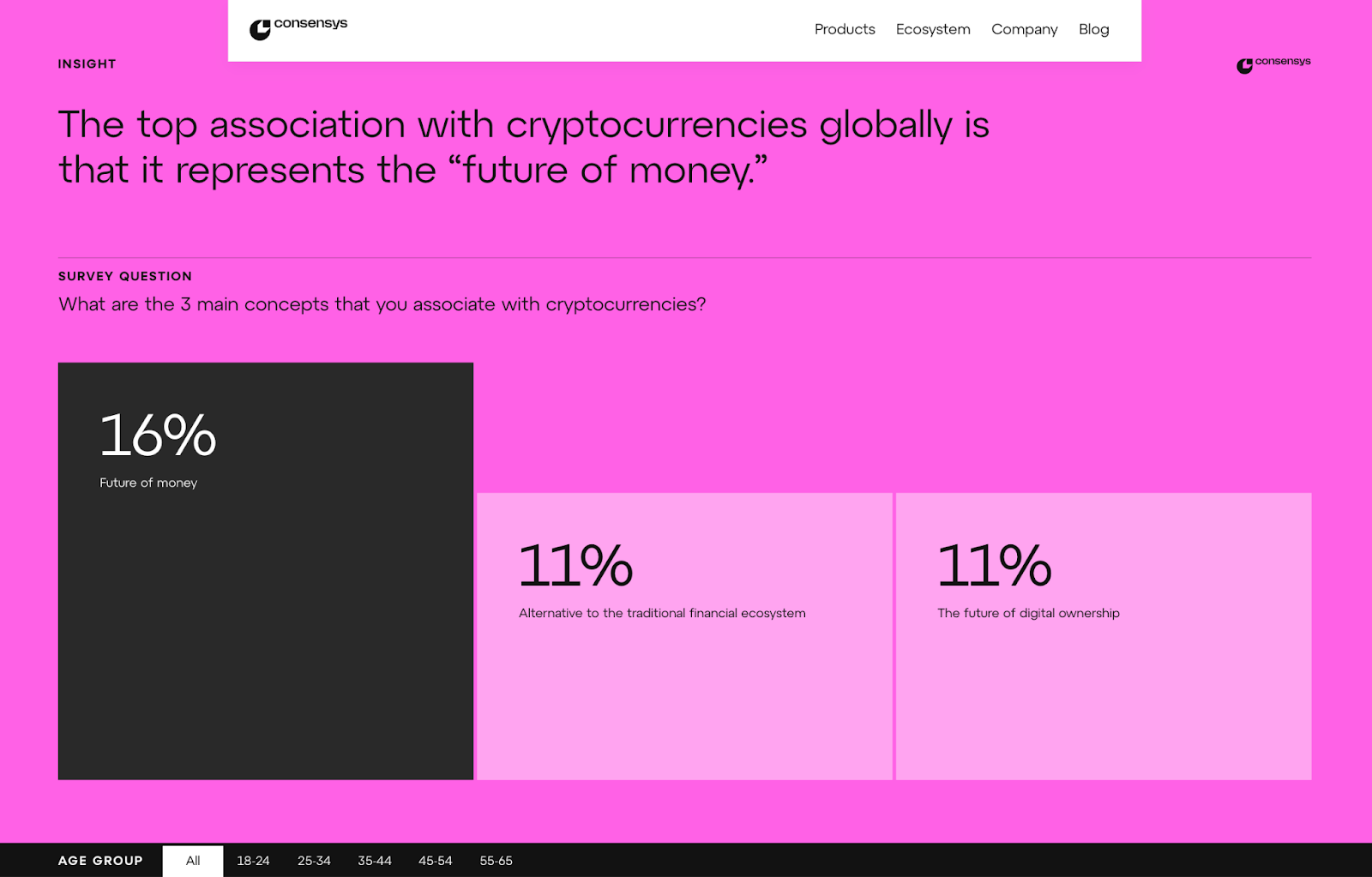Disclosure: The views and opinions expressed here belong solely to the author and do not represent the views and opinions of crypto.news’ editorial.
Consensys surveyed around 15,000 people worldwide, and 92% said they ‘heard about’ crypto. What’s more: 50% of respondents ‘understand’ the asset class. Such understanding was especially high among people from emerging economies like Nigeria, Brazil, India, etc.
Crypto awareness | Source: Consensys
These data points highlight the rising interest in crypto and related technologies. But there’s still much to do in terms of educating the masses about crypto concepts.
Most people have only ‘heard about’ crypto or had little hands-on experience, frequently negative ones: bad UX, scams, etc. Helping users truly understand crypto is thus the key to sustained, long-term adoption. Because when knowledge is power, education is empowerment.
The sad state of financial literacy
Everyone today has financial needs and uses money. But only about 33% of adults worldwide are financially literate. This is the main reason financial crimes and mishaps are so common, especially in emerging domains like crypto.
When most people don’t understand finance in general, it’s only natural that they’d understand new asset classes, their market dynamics, and technical underpinnings even less. Inherent limitations and sub-par UX aside, low awareness and steep learning curves hamper crypto’s adoption.
Malicious actors are quick to capitalize on these inadequacies, targeting unwitting users via scams, rug pulls, and phishing attacks at scale. Building robust security frameworks and easy-to-use processes is crucial to solving this problem. But in a user-driven domain like crypto, it’s equally important — if not more — that individual users make fewer mistakes and more informed choices.
Web3 mustn’t repeat web2’s mistake (deliberately or otherwise) of spoiling end-users with convenience alone, without fostering meaningful technical and financial awareness. Particularly if we’re to fully realize its progressive principles: user autonomy, privacy, distributed decision-making, etc.
While ‘hassle-free’ systems can help onboard the ‘next one billion crypto users,’ accessible education will turn them into active contributors in the journey towards effective decentralization. And the timing is also just right, with over 60% of parents in the United States agreeing that their wards must learn about crypto at school.
Let’s learn crypto, but where?
Industry stakeholders have increasingly focused on crypto education in recent years, from identifying its role in empowering female and Latin American users to forming multilateral platforms like Bitcoin Policy UK (BPUK). Broader benefits like reduced ‘technostress’ — the modern disease caused by the inability to cope with new technologies — have also come to light.
But we’re still lagging behind with regard to producing accessible, high-quality educational material for the masses. That’s not to say no one is producing good educational content around crypto. Ethereum, Binance, Ledger, and other leading platforms create rich explainers, white papers, reports, etc. to build awareness.

Concepts associated with crypto | Source: Consensys
Most crypto publications do something similar, keeping users updated. YouTubers are going at it as well, offering diverse content from reviews to market analysis and in-depth explainers. Crypto project owners and developers also regularly share their insights, experiences, and opinions across the web — these are excellent educational materials, though often for slightly advanced users.
Lack of educational material isn’t the main problem thus. Instead, it’s a question of accessibility. While there’s an abundance of crypto-related blogs, articles, videos, and newsletters, education is often the means to an end and not the end itself.
The tech-savvy individuals, driven by insatiable curiosity and will to knowledge, dive into ‘rabbit holes’ to learn about crypto. They follow link trails to gather the information or explanations they need when they need them. The user experience isn’t an obstacle for most parts, mainly because they’re already exposed to a broader vision.
That’s not how it works with the masses, though. Easy access to structured and engaging material is key to getting them interested — hooking them, so to say — at least initially. Simple, but not trivial, content is a must to this end, and that’s something we’re missing currently.
Learning through fun and engagement
Providing factually correct, in-depth information isn’t enough for mass education in this age and time of social media. With so much content available at hand, users now tend to consume only what appeals to them the most. For most parts, they ‘cancel’ whatever’s boring or uninteresting.
It’s perhaps more true for educational content than anything else, given the negative associations people often have with learning — courtesy, centralized, institution-centric education systems. And anyway, many studies have shown that the fun way is the best way to learn something.
Having fun gives learners a dopamine hit, boosting their memory, attention, and motivation to learn. Crypto educators and content creators must therefore prioritize engagement while designing educational materials, courses, or the like. With that sorted, they must also consider the form or educational medium carefully.
Written content — blogs, articles, books, reports, etc. — have been the staple for a long time, and they’re still very relevant with regard to crypto education. Creating written material is also often easier and more feasible vis-à-vis, say, podcasts or videos. But from the engagement PoV, video is the king, and it’ll remain so in the near future.
Over 65% of people are ‘visual learners’ or spatial learners, i.e., they ‘learn and remember best through visual communications.’ Another 30% are ‘auditory learners’ who thrive while hearing things. The best thing about videos is that they cater to both of these dominant learner types. Engaging, informative, and fun videos are thus the most accessible educational medium, great for amateurs and pros alike.
That being said, it’s high time to turn realizations into actions by building dedicated educational resource pools that learners can access easily in a structured manner. They shouldn’t have to run from one source to another, and above all, education must be free.
The sooner we achieve these goals, the faster we’ll witness crypto’s mass adoption; that too, sustainable and long-term. And thankfully, it’s not a question of if but when.





